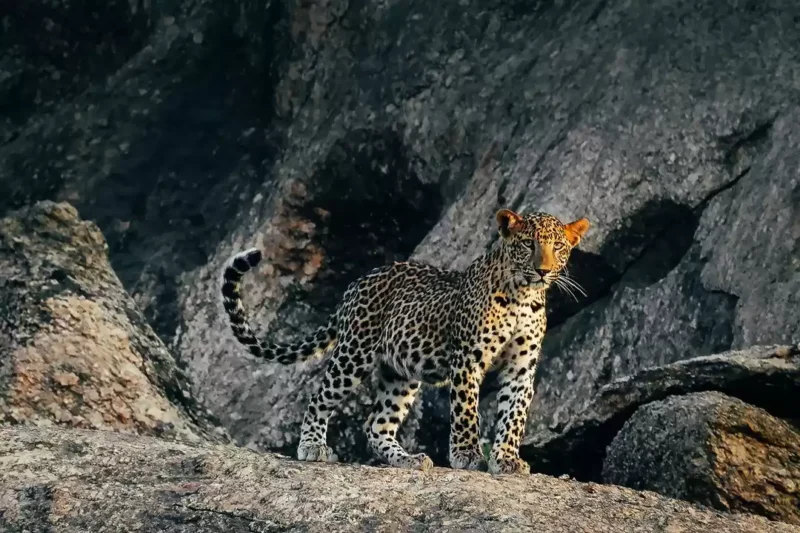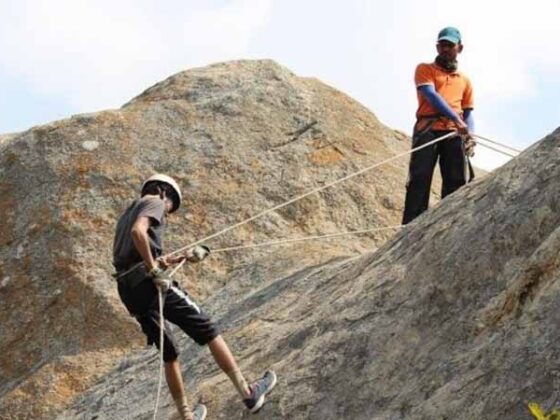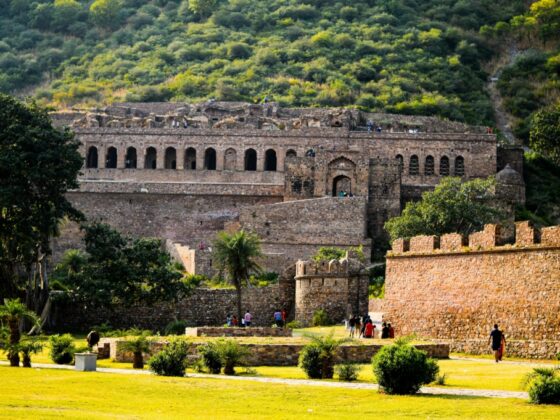Spotting Leopards at Bagheera’s Camp, located in the beautiful and remote region of Jawai, Rajasthan, is a unique wildlife and nature retreat that offers visitors an unforgettable experience. This eco-friendly camp is well-known for its prime location, offering the chance to observe wildlife, especially leopards, in their natural habitat. The Jawai region is famous for its rocky landscape, scenic beauty, and diverse wildlife, making it a hidden gem for nature lovers.
1. Location and Accessibility
- Situated at Jawai Bandh, Bera: Located in Rajasthan, about 6 hours drive from Ahmedabad.
- Best Access Routes:
- By Road: From New Delhi (607 km), by car in 10 hours.
- By Air: Nearest domestic airport in Udaipur (140 km away).
- By Train: Jawai Bandh Railway Station (10 km away), or Falna Station (30 km away).
2. Accommodation
- Eco-Friendly Stays: Options include deluxe tents, eco-friendly cottages, and dormitories for groups. Luxury suites and camping tents are available.
- Facilities:
- No air-conditioning or TV, promoting a digital detox.
- Basic eco-conscious amenities such as water conservation, organic food options, and comfortable bathrooms.
- Rooms are spacious, providing a perfect blend of comfort and nature.
3. Wildlife and Safari Experiences
- Leopard Sighting: Spotting Leopards at Bagheeras’ Camp ,Leopards can be spotted in the evenings and early mornings, especially around the caves near Lilada hill.
- Safari Timings:
- Morning Safari: 5:30 a.m. to 7:00 a.m.
- Evening Safari: 5:30 p.m. to 7:00 p.m.
- Safari Cost: Rs. 3000-3500 per person (depending on time and jeep type).
- The leopards population around Bera is around 70, and sightings can be frequent if you stay for 3-4 days.
- Jeep safaris can be arranged to various leopard sighting points like Lilada, caves, and the Jawai Dam area.
- Safari Timings:
4. Nature Trails and Bird Watching
- Trails: Several trails are available to explore, ranging from 2-6 km. They offer unique opportunities to explore local flora and fauna, including rugged cliffs, rivers, and caves.
- Bird Watching: A haven for birdwatchers, with species like Shikra Hawks, Black Shouldered Kites, and migratory birds.
- Notable Birds: Red Vented Bulbuls, Green Bee-eaters, and more.
- Best observed from the tent area or during early morning/evening walks.
5. Cultural and Local Attractions
- Local Villages and Temples: Visit to Kambeshwar Mahadev Temple, a sacred site with occasional leopard sightings. The local villagers also play a role as “leopard trackers.”
- Cultural Experience: Engaging with local tribes like the Khadia and Mankadia, who have lived harmoniously with the wildlife.
- Eco-Friendly Initiatives: The camp has a social enterprise model, providing education and hospitality training to local village children and offering employment.
6. Gastronomy
- Vegan and Organic Food: The food served is mostly home-cooked, vegan, and sourced from organic farms.
- Signature Dishes:
- Bajra rotlas, Rajasthani dal, and Bajra porridge.
- Vegan specialties like Laukee Soup, Roasted Sweet Potatoes with Coriander Chutney, and Roasted Batis with vegan dal.
- Fresh fruits and nuts available for self-sustained snacks during safaris.
7. Sustainability and Eco-consciousness
- Environmentally Sensitive: Spotting Leopards at Bagheeras’ Camp operates with minimal environmental impact, using recycled materials for construction and promoting water conservation.
- Local Wildlife Conservation: Ongoing efforts to increase the prey base for leopards, thus promoting a more balanced ecosystem in the region.
- Cultural and Natural Preservation: Actively supporting local tribes and preserving the natural beauty and integrity of the area.
8. Leisure and Spiritual Experience
- Sunrise and Sunset Views: A beautiful experience, especially from the jeep or while walking through the forests to view wildlife.
- Meditation Huts: For those seeking solitude and spiritual reflection amidst nature’s tranquility.
- Full Moon Experiences: A special opportunity to stay on a rocky hill with panoramic views, ideal for nature lovers and spiritual seekers.
9. Photographic Opportunities
- Wildlife Photography: Ideal for bird watchers and wildlife photographers due to the pristine location and abundant species.
- The best gear is a handheld point-and-shoot camera with good optical zoom, as it’s about timing and not about bulky equipment.
- Sunrise and Wildlife Shots: Capturing the dramatic landscapes, leopards, and birds in natural habitats.
10. Activities and Nearby Attractions
- Leopard Watching: Twice-daily safaris with a high chance of sighting the elusive leopard.
- Other Wildlife: Blue Bulls, Common Indian Langurs, Desert Fox, and various migratory species.
- Jawai Dam: A short drive from the camp, offering sightings of crocodiles and birds, perfect for an early morning visit.
- Cultural Visits: Explore the local temples, caves, and wildlife hotspots.
11. Best Time to Visit
- Optimal Season: October to March, when the weather is most pleasant, with chilly mornings and evenings.
- Winter Visits: Can be extremely cold during late evening and early mornings (7 p.m. to 7 a.m.), so pack warm clothes.
12. Booking and Contact Information
- Booking: Contact Padmaja Singh Rathore (+91-8209039762) for reservations.
- Accommodation Rates:
- Luxury tent: Rs. 4500-6500 per night, depending on the suite.
- Luxury suite: Rs. 33,000 per suite, inclusive of meals and two safaris.
- Safari costs: Rs. 3000-6000 per jeep depending on the safari time.
Conclusion:
Spotting Leopards at Bagheeras’ Camp offers a unique blend of adventure, luxury, and eco-conscious living, making it a perfect destination for nature lovers, wildlife enthusiasts, and those looking for a tranquil retreat. Whether you’re after leopard sightings, birdwatching, spiritual solitude, or a culturally immersive experience, this eco-friendly resort in the heart of Rajasthan’s wildlife will ensure you have an unforgettable stay.










